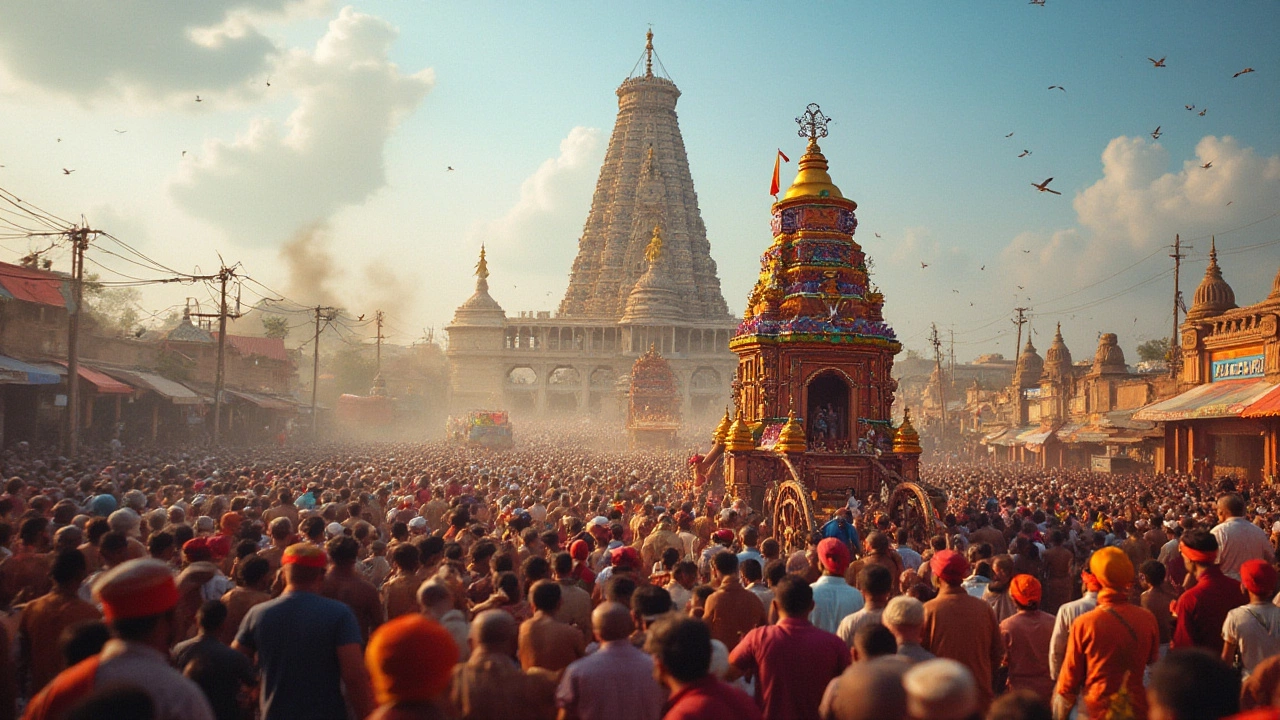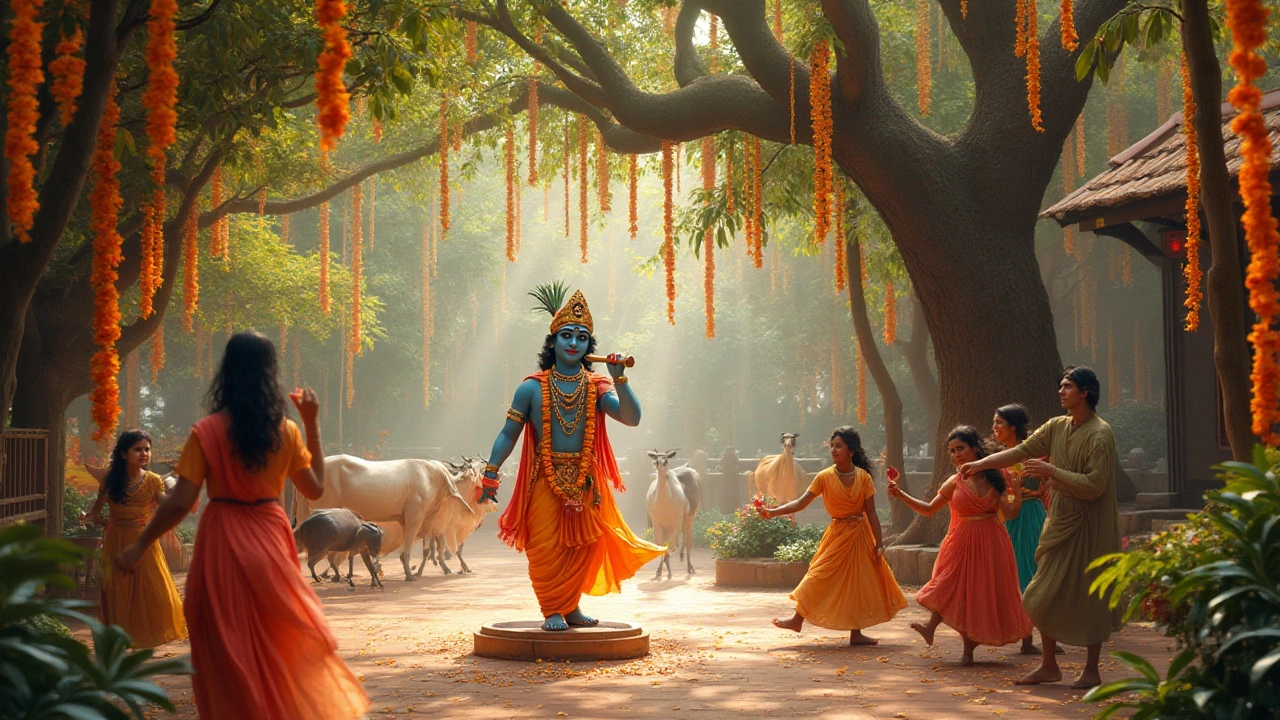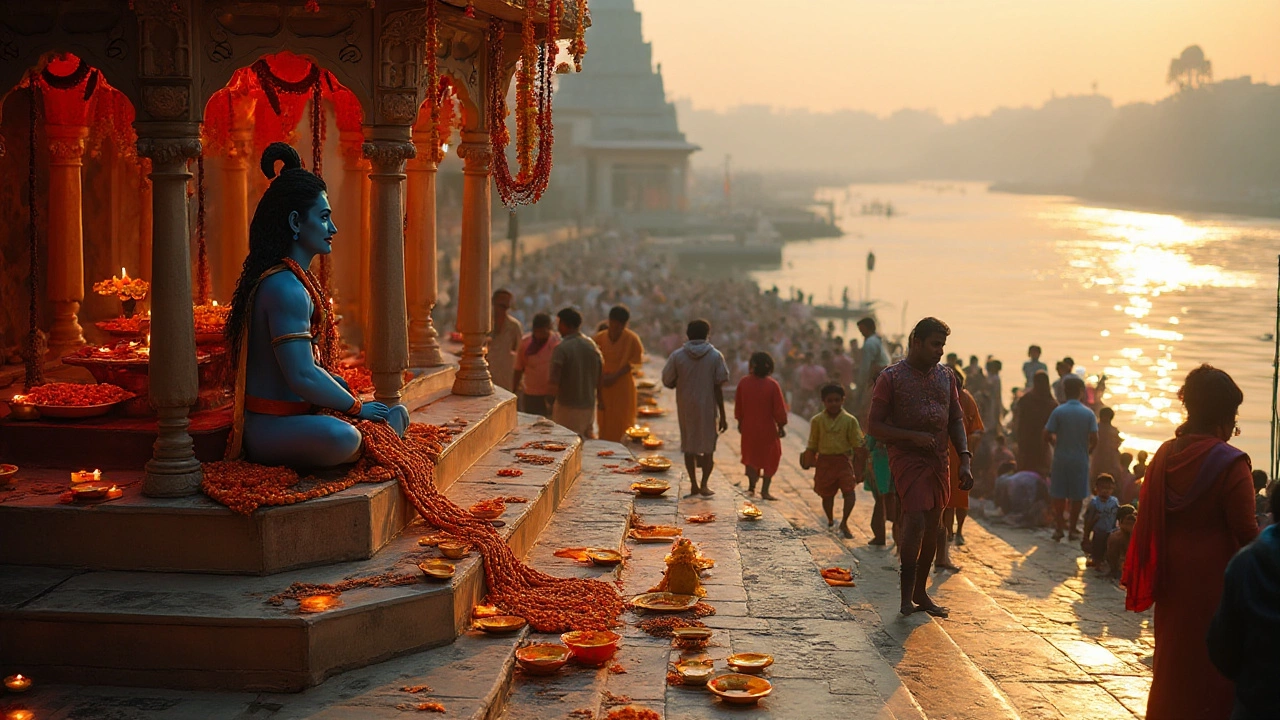India's rich tapestry of beliefs comes alive through its myriad deities, each representing different aspects of life and the cosmos. These gods are not just celestial figures but beloved entities woven into the very fabric of daily life, culture, and history in India.
While the subcontinent's spiritual landscape acknowledges thousands of gods, a select few stand out due to their overwhelming popularity and widespread veneration. This article delves into knowing who these deities are and why they command such devotion among millions of followers. It's an exploration of spirituality that shows not just numbers or idols, but profound relationships and cultural narratives that have traveled through time.
- Introduction to Hindu Deities
- Vishnu: The Preserver
- Shiva: The Destroyer
- Durga and Feminine Divine Powers
- Ganesha: The Remover of Obstacles
- Conclusion: Spiritual and Cultural Significance
Introduction to Hindu Deities
Hinduism, often celebrated as the world's oldest religion, offers a vast tapestry of beliefs woven intricately around a multitude of deities. Each deity embodies specific virtues, cosmic tasks, and moral lessons, presenting a divine hierarchy and an organic blend of mythology and philosophy. This vibrant array of gods and goddesses may initially seem bewildering, yet they represent a unified spiritual essence expressed through diverse cultural stories. At the heart of Hinduism is the concept of Brahman, the ultimate reality and source from which everything emanates, receiving various forms and names in the earthly realm as deities.
The three principal deities, widely known as the Trimurti, embody the essential roles of creation, preservation, and destruction. Brahma, Vishnu, and Shiva are pivotal to the cycle of the universe—the genesis, continuation, and transformation of all life. Brahma, though less prominently worshipped today, is revered as the creator, offering profound wisdom and insights into the beginning of time and meaning of existence. In contrast, Vishnu and Shiva receive extensive reverence, adored for their direct involvement in maintaining and dissolving the cosmic order, respectively.
Intriguingly, Hindu deities possess deeply human attributes, making them accessible and relatable to devotees. God's divine play, or 'Lila,' enacts through tales imparting complex philosophies with simplicity and charm. Many scholars are enchanted by how these stories are living entities, evolving with society yet staying true to their core messages. Notably, Indian scriptures like the Vedas, Tamil literature, and epics such as the Mahabharata and Ramayana are rich deposits of these divine narratives, providing both moral and spiritual guidance.
While the Trimurti is undeniably central, the Pantheon is diverse with gods like Ganesha, revered for wisdom and obstacle removal, and goddesses such as Durga and Lakshmi, symbols of power and prosperity. Each has a unique role and representation in art, literature, and temple architecture, offering a visually captivating spiritual journey. The multitude of manifestations, avatars, and myths around these gods enriches the cultural and spiritual landscape of India, making it a domain where faith and tradition create a vibrant existential mosaic.
Remarkable as it sounds, Hinduism's universal reach allows personal interpretation and engagement, encouraging devotees to choose deities resonating with their individual spiritual quests. Many Hindus believe visiting these deities in their sacred domiciles confers blessings, leading to the tradition of temple tours India practices ardently. For scholars curious about this phenomenon, a delightful irony is how this polytheistic tendency speaks to a profound underlying monotheism, focusing on the divine's all-encompassing presence.
"Hinduism is more than a faith; it is a core of Indian identity, a living philosophy that resonates with personal and collective experiences." - Sarah Caldwell, Religious Studies Scholar.
Vishnu: The Preserver
Among the pantheon of Hindu gods, Vishnu is revered as the supreme preserver and protector of the universe, a role that projects him as a pivotal figure for his devoted followers. His significance is ingrained in every myth and scripture that discusses the upholding of righteousness (dharma) against the forces of chaos and evil. Unlike other deities who might embody a more singular focus—such as creation or destruction—Vishnu is known for his role in maintaining the cosmic order.
Understanding Vishnu starts with knowing his ten incarnations, known as the Dashavatara, each form reflecting different eras and lessons for humanity. Among these, Rama and Krishna hold a special place in Indian spiritual and cultural life, celebrated through epic texts such as the Ramayana and the Mahabharata. These avatars are not just tales of divine intervention but deeply instructive narratives steeped in moral and ethical questions.
Vishnu's appeal lies not only in these stories but in the philosophical doctrines that he anchors, predominantly the Vaishnavism tradition, which has inspired countless devotees. This sect's teachings have guided generations, emphasizing the path of bhakti—devotion and love as the means to connect with the divine. In temple tours across India, the influence of Vishnu is evident, with grand temples like the Venkateshwara Temple in Tirupati and the Jagannath Temple in Puri attracting millions of pilgrims each year.
The Bhagavad Gita, part of the Mahabharata, is a vital scripture that highlights Vishnu's role as a guide and philosopher. It states, "Whenever there is a decline in righteousness and an increase in unrighteousness, at that time I manifest myself on earth."
Such teachings place him as a central figure for those seeking guidance through difficult moral landscapes, making him a relatable and accessible god. His temples are more than places of worship; they are centers of cultural education, charity, and community gathering, reflecting the broad impact of his divinity in tangible ways.
Devotees are often seen participating in vibrant festivals dedicated to Vishnu, such as Diwali and Holi, where his life's stories are retold with passion and joy, cementing their ethical values and lessons in the community's psyche. These celebrations are bolstered by artistic expressions—music, dance, and drama—that carry the teachings beyond the temple walls into everyday life.

Shiva: The Destroyer
Shiva, one of the principal deities of Hinduism, holds a unique space in the hearts of millions, captivating devotees with his mystique and duality. Known as the "Destroyer" within the sacred Hindu trinity, Shiva embodies more than just the end; he represents regeneration, transformation, and the cyclical nature of existence itself. This multifaceted god, both fearsome and benevolent, is revered across India for the essential balance he brings to the cosmic order — a reminder that destruction is followed by creation, making way for rebirth and renewal. Many are drawn to Shiva for his ascetic lifestyle, often depicted meditating atop the mystical Mount Kailash, with the serene face of one who transcends the material world.
Shiva is often worshipped in the form of the Shivalinga, an abstract representation that signifies his infinite nature. The light of the great yogi is sought by those searching for internal peace, liberation, and spiritual insight. Temples dedicated to Shiva are spread across India, with the Kashi Vishwanath Temple in Varanasi being among the most famous, claiming a spiritual legacy of nearly a millennium. Pilgrims flock to such temples, seeking the divine grace of Shiva, believed to cleanse sins and offer moksha — liberation from the cycle of birth and death. A fascinating aspect of Shiva's persona is his portrayal as both a fearsome deity with a temper as explosive as the cosmic dance of destruction, Tandava, and as a loving husband to Parvati, and a protective father to Ganesha.
A glimpse into the legends of Shiva reveals narratives rich with ethical lessons and philosophical depth. One such saga tells of the churning of the ocean, where Shiva swallows poison to save the world, reminding humanity of sacrifice and selflessness. His constant companionship with Nandi the bull, and the symbolic presence of the snake around his neck, further add layers to his enigmatic personality. Shiva's followers express devotion in myriad ways during festivals like Maha Shivaratri, characterized by fasting, elaborate rituals, and fervent chants of "Om Namah Shivaya." As Richard Davis eloquently expresses, "Shiva's mythology encompasses everything good and bad, beautiful and ugly. Shiva functions as a paradox." In celebrating Shiva, devotees embrace complexity, finding strength in dualities and accepting change as the truth of existence.
Durga and Feminine Divine Powers
In the vast pantheon of Indian deities, Durga embodies the quintessential feminine energy, brimming with valor and compassion. Revered as the warrior goddess, she represents the epitome of shakti, or power, which plays a crucial role in the Hindu spiritual framework. Her iconography is compelling: Durga is depicted riding a lion or tiger, armed with a myriad of weapons and slaying the buffalo demon, Mahishasura. Her visage exudes strength and serenity, a reflection of the divine balance she maintains between destruction and mercy. Durga's origins are deeply rooted in ancient myths, particularly in the Hindu texts known as the Devi Mahatmya, where she emerges to restore cosmic balance when the forces of evil threaten to tip the scales.
One cannot overlook the cultural tapestry that Durga's worship weaves across India, with temple tours revealing an awe-inspiring network of shrines dedicated to her. The awe-inspiring Durga Puja festival celebrated predominantly in West Bengal is a testament to her vast following. For ten days, devotees immerse themselves in rituals, music, and dance, culminating in the immersion of her idols in rivers—a symbolic return to her celestial abode. "Durga's worship is not just about ritual; it's about invoking that extravagant energy that resides within and makes you fearless," says acclaimed writer Devdutt Pattanaik in his insightful explorations of Indian mythology.
Beyond Durga, the feminine force in Hinduism is vast and varied, encompassing myriad forms like Lakshmi, Saraswati, and Kali. Each goddess represents different facets of life—prosperity, knowledge, and transformative power. The reverence for feminine divine powers signifies a narrative of empowerment and acknowledgement of women's pivotal roles in both spiritual and societal realms. Interestingly, a survey conducted in 2022 indicated that approximately 80% of Indian households actively participate in festivals honoring female deities, reflecting their omnipresent influence in daily life. The intricate stories of these goddesses inspire art, literature, and music, resonating deeply within cultural conversations around gender and divinity. The belief in the feminine divine is not just a story from the past but a living, breathing practice that continues to shape contemporary values and spiritual identities.

Ganesha: The Remover of Obstacles
In the vast pantheon of Indian deities, Ganesha occupies a special place as the beloved son of Shiva and Parvati, revered as the God who transcends all barriers. With an elephant head and rotund human body, he is honored at the beginning of most rituals and ceremonies, symbolizing auspicious beginnings and the clearing of interferes. This distinctive deity is cherished across regions, castes, and faiths within India, making him arguably one of the most universally worshipped gods in Hinduism.
The legend of Ganesha's creation is as captivating as any epic, marked by divine whimsy and profound meaning. It is said that he was fashioned by Parvati from the earth and dust of her own body while Shiva was away in meditation. Upon Shiva's return, a misunderstanding led to the severing of the child's head, inducing Parvati's wrath. In a gesture of reconciliation, Shiva replaced his head with that of a mighty elephant, thus granting him not only life but immense wisdom and strength.
"The elephant symbolizes wisdom and memory," notes renowned mythologist Dr. Devdutt Pattanaik, "and by overcoming his obstacle-laden life, Ganesha teaches us how to synthesize disparate elements into something extraordinary."
Ganesha's popularity isn't just woven into myths but echo in starlit celebrations across India, especially during Ganesh Chaturthi, a vibrant festival that invites communities to immerse in large processions, resplendent décor, and fervent mantras. This festival, which lasts up to eleven days, sees millions participating in the making, worshipping, and culminating immersion of the clay idols into waters, symbolizing the cycle of birth, life, and renewal, hallmarks of Hindu philosophy.
Besides his elephantine visage, Ganesha is often depicted with an ensnared mouse at his feet, which he uses as a mount. This peculiar image encapsulates the intricate duality of life—addressing the mighty and the meek without judgment or prejudice. The mouse signifies the ego, unchecked and rampant, while Ganesha represents the soul's power to harness and direct it for higher purposes. Temple tours India prominently feature diverse Ganesha temples like the grand Siddhivinayak Temple in Mumbai or the Rockfort Ucchi Pillayar Temple in Tamil Nadu, each illustrating unique aspects of the deity's influence.
In the realm of astrology and numerology, Ganesha's role as a problem-solver extends to divine guidance and decision-making, which is why many start their ventures by reciting his mantras. His multifaceted nature resonates profoundly with seekers of wisdom and centers the values of faith and resilience. Such attributes not only contribute to his legendary status but reinforce the belief that life's burdens are merely obstacles in disguise, waiting for the right mindset to overcome them. His lessons, transcending religious doctrine, offer universal truths that appeal to devotees and spiritual enthusiasts across the globe.
Conclusion: Spiritual and Cultural Significance
Diving into the spiritual landscapes of India, one cannot overlook the seamless intertwining of faith and culture in its worship of deities. Each god, from the sustainer Vishnu to the transformative power of Shiva, plays a unique role in both the cosmic play and the socio-cultural quilt of this diverse nation. These deities are not merely venerated figures but serve as moral and ethical guides embedded in countless stories passed down through generations. Their temples, grand and humble alike, are beacons of devotion and living threads that connect communities, stories, and histories.
The rich tapestry of the Indian subcontinent is vibrantly colored by its gods, each influencing daily life, festivals, art, and values. These Hindu gods are celebrated through a blend of rituals and ceremonies that highlight not just spiritual reverence but also cultural unity. Take Ganesha, the elephant-headed god known widely as the Remover of Obstacles. His statues often grace the entrances of homes and businesses, and he is worshipped before any new venture, illustrating how deeply ingrained these beliefs are in everyday life. Interestingly, during the festival of Ganesh Chaturthi, sumptuous feasts and elaborate processions become a tapestry of both spiritual expression and community bonding.
"India's soul resides in the spiritual connection between its people and their deities, a connection illustrated through vibrant festivals and cultural expressions.” – Dr. Anjali Mehra, HistorianThis profound relationship has fueled not just individual spirituality but social structure, art, and politics throughout India's history. Temples like the Jagannath Puri and the Kashi Vishwanath hold centuries of history and are custodians of countless tales of devotion and miracles, playing key roles in shaping regional cultures and spreading spiritual teachings across borders.
A modern reflection on these ancient practices illustrates that while the portrayal of gods might evolve, their essence and influence remain stalwart. Mass pilgrimages such as the Kumbh Mela, attracting millions of devotees, portray the continued significance of these practices in modern times, providing an unprecedented look into communal faith. Delving into the pulse of such vibrant gatherings offers insights into not only modern religious devotion but also a unique socio-cultural phenomenon that defies simplistic explanations. These events encapsulate India's rich traditions, and the interplay of faith and modernity, making them a spectacle of belief and cultural exchange.
Through this celebration and worship, Indian deities foster a living heritage that is adaptable and resilient, transforming with time yet stable in their core message. Such spiritual devotion extends beyond borders, influencing global perceptions and practices related to Indian culture. The blend of ritual, tradition, and spirituality associated with these gods is a reminder of the power of faith to inspire resilience, creating a sense of belonging and identity among worshippers, wherever they might be. The essence of these beliefs highlights a universal truth about the human need for connection, a testament to their unquestionable impact across ages and cultures.
